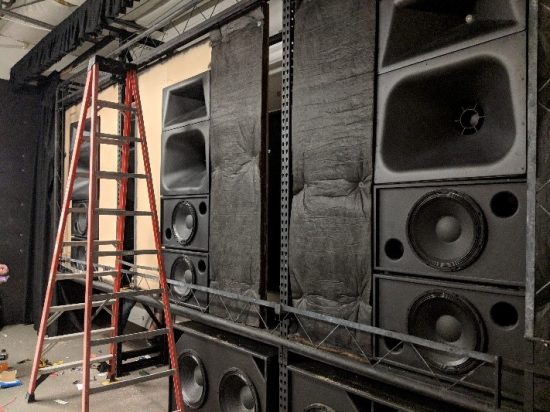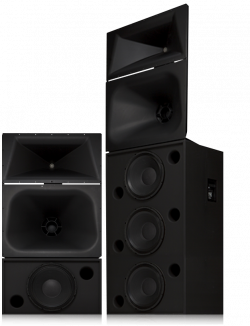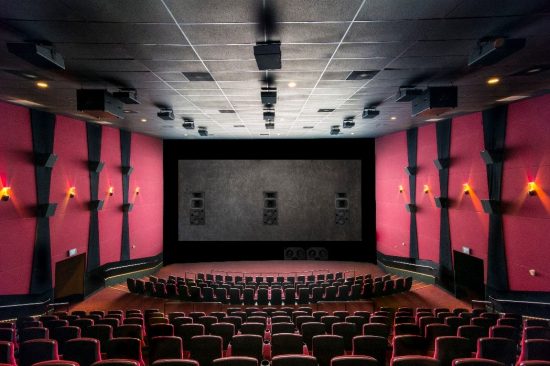We are often asked to design “the best sound system” by a cinema owner. While we appreciate the opportunity to provide audio gear with outstanding performance, great sound requires more than just great equipment. Getting it right requires that you pay attention to each of these Six Steps. Skipping even ONE, will not get you the results you want.
Applying structure to the process can result in high performing systems that are repeatable, and cost-effective. There is no luck or magic involved. It’s not simple, but it’s also not rocket science.

1. Get the Room Right
It starts with room itself. A properly designed room for cinema is neither square nor shaped like a shoebox or bowling alley. Ideal length to width proportions – for both sound and sightlines – is usually between 1.2 to 1.5.
Acoustic treatment is a must, especially along walls near the screen, the rear wall at the back of the room, behind the screen, and even over the ceiling tiles. Baffle walls or “bafflettes” are extremely helpful.
Acoustic Isolation and low noise needs to be designed in. It is very expensive, if not impossible, to fix walls after opening.

2. Get the Speakers Right in the Lab
Don’t try to “fix” a bad speaker or a bad room with high resolution, in-situ measurements and a lot of equalization. It can’t be done. It is more likely to make a bad situation worse, not better.
You also can’t fix poor directivity with EQ. It may look good on the RTA, but poor directivity results in a “bumpy” response from the direct sound that reaches the listener and won’t sound good. It’s good to trust your measurement equipment, but it’s better to trust your ears.
If you need more SPL, use bigger and better speakers, not bigger amps. More subs sound better, last longer, and can use smaller amps. If two subs are good, four are better.

3. Amplifier Guidelines
Cinema soundtracks have big peaks and low average power. They are not like the sine waves that many published specifications are based on.
Multi-channel amps can share power from the same power supply when some channels are heavily loaded and some are lightly loaded.
There is no need to “over-spec”. Take advantage of the high voltage rails of QSC DPA-Q and CX-Q Series class D amplifiers for outstanding headroom without breaking the bank. For most bang for the buck, put any extra funds into the loudspeakers.

4. Speaker Placement
The biggest error we see is mounting screen speakers too low behind the screen. That results in poor front-to-back coverage – too loud in front and too soft in the rear. The middle of the screen channel mid-high horn should be at about 5/8 screen height, and they should be no more than 6” from the screen.
This sounds obvious, but be sure to point the screen channel horns at the audience (yes, we’ve seen it all). Proper tilt is required to make sure front and rear rows are covered by the HF horn, and “toe-in” left and right speakers to keep sound off the side wall and to cover the far corners of the room.
Put the subs together in a tight stack. Put them slightly off center on the floor. Don’t put them in two stacks on either side of the screen. Symmetry may look good, but it can result in cancellations exactly where you don’t want them.
Don’t mount the surrounds too low. One height is not right for all rooms. Wider rooms need higher surrounds. This creates a bigger stereo “sweet spot”, so more of the audience hears more balanced sound.
Use enough rear wall surrounds for 7.1 systems. Even in small rooms, two speakers on the back wall is not enough for 7.1. If you don’t have enough speakers, consider using 5.1 instead.

5. Installation and Calibration
It is critical to verify that the speakers are configured and wired correctly before starting to EQ (again, we’ve seen it all).
Many screen channel speakers have mode switches, like the bi-amp/tri-amp switch on the DCS 3-way screen channels – make sure they are set correctly for the system design.
Also check for correct polarity wiring for all speakers, and make sure HF and LF amps are connected to the correct speaker components. These are very simple yet common mistakes that can make it impossible to get proper performance from your loudspeakers. Verify that all channels are connected to the correct speaker locations in the room, especially surround speakers.

6. Amaze the Audience
A lot of moviegoers have never really experienced GREAT or even GOOD Cinema sound!
They will know it when they hear it, and it will help make your cinema their preferred place to see and hear a movie.
Check out our “Good Cinema Sound Checklist”, and share with your staff. For more resources on this and other cinema-related topics be sure to check out our other blogs and recorded webinars and let us know in the comment section below if this article was helpful to you.
